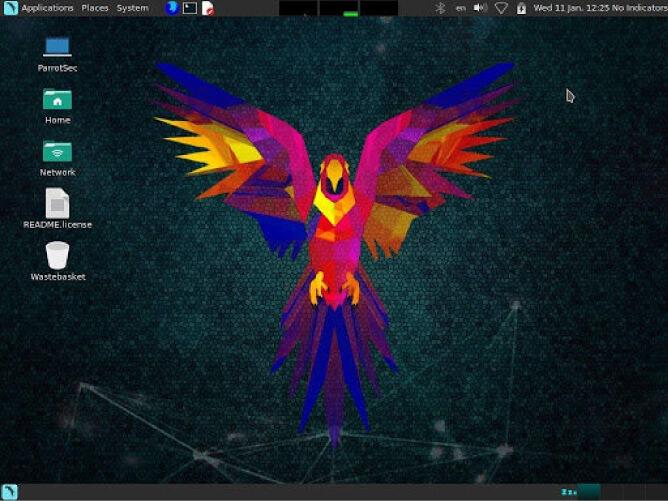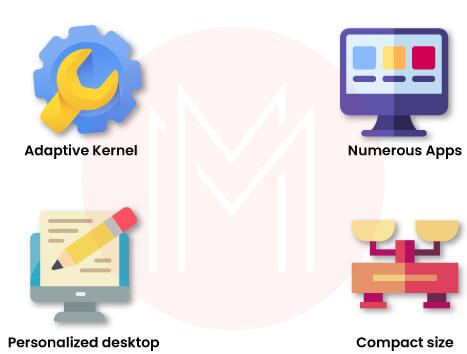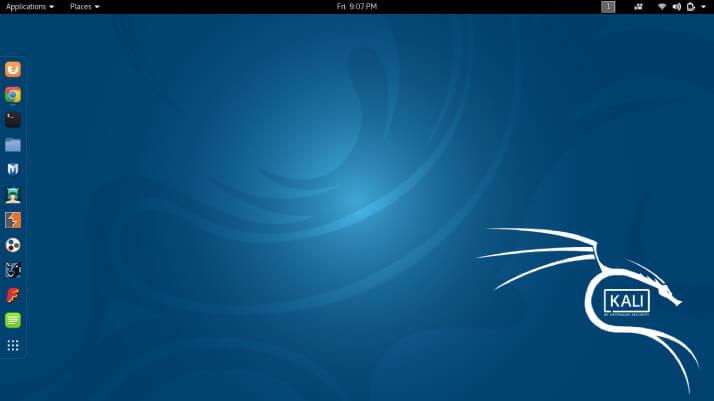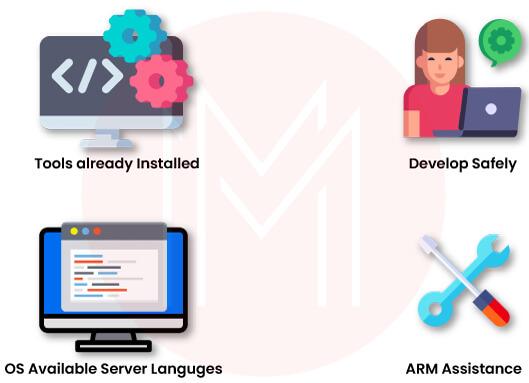- Linux Commands for Beginners
- Linux Environment Variables
- Linux File Permissions
- Linux Interview Questions
- Linux Kernel Tutorial
- Linux Networking Commands with Examples
- What is Linux? - A Complete Beginners Tutorial
- Linux vs Unix
- Linux Advanced Functions And Commands
- Introduction to Linux Operating System
- Monitoring Tools in Linux
- Top 10 Reasons Why You Should Learn Linux
- Shell Scripting Tutorial
- What is Kali Linux ?
- What is Linux Operating System?
- Arch Linux Vs Ubuntu
- Network Administrator Interview Questions
- Linux Projects and Use Cases
- Linux Connect to MySQL
- Linux Networking Tutorial
Well, if we're talking about Linux, let me be clear that it's a popular operating system among programmers and security hackers. Apart from that, though, we shall only compare Kali Linux and ParrotOS in this article today.
There is a wide range of patterns available for Linux in the market. While Kali Linux is the most popular pattern used by the majority of penetration testers and security experts. While the Parrot Security OS is made up of pen testing, ethical hacking, and other computer criminological activities, it is also very cloud-friendly. Thus, ParrotOS is a fairly lightweight Linux system when compared to other Linux variants.
As a result, Kali has undergone multiple major updates, and various penetration testing cybersecurity-related firms have also been displayed globally.
Thus, we will compare Kali Linux with ParrotOS in this post and determine which is better for ethical hacking. Therefore, let's get started right away and simply read the entire essay.
| Table of Content - Parrot OS vs Kali Linux |
What is ParrotOS?

A Linux operating system, specifically one based on Debian, called Parrot Security OS was originally made available to ethical hackers and penetration testers in 2013. Parrot OS can be viewed as a mobile lab for a variety of cyber security management tasks, including digital forensics, reverse engineering, and pen testing. Additionally, it includes everything you require to create your applications and protect your data.
Users of Parrot OS have access to a variety of sandboxing and hardened options, and it is frequently updated. The tools in the package are designed to function with the majority of hardware that makes use of containerization software, such as Podman or Docker. Parrot OS is a fantastic replacement for systems with outdated hardware or low resources because it is incredibly lightweight and works shockingly quickly on all PCs.
It features a separate "Forensics Mode" that is far more stealthy than its regular mode because it does not mount any of the platform's hard discs or volumes and has no impact on the host system. This mode is employed on the host system to carry out forensic operations.
| If you want to enrich your career and become a professional in Linux, then enroll in the "Linux Training Course" - This course will help you to achieve excellence in this domain. |
Features of Parrot Security

- Adaptive Kernel: Along with a vast library of scripts, Parrot Security also features a specially modified Linux kernel that serves as the first line of defense by providing as much protection and resistance to invaders as feasible.
- Numerous Apps: All the tools of Kali Linux, a well-known operating system for penetration testing, are included in Parrot Security, along with a few more for good measure. While keeping the size of the two operating systems essentially the same, this was accomplished.
- Personalized desktop: They offer MATE and KDE, two different desktop environments that are typically pre-installed. If you're not familiar with Linux jargon, think of desktop environments as the main Linux distribution user interface.
- Compact size: The compact size of Parrot OS over Kali Linux is one of its key advantages. This means that it works properly with as little as RAM 320MB and much less disc space and processing power.
What Is Kali Linux?

An advanced Linux-based operating system called Kali Linux, formerly known as BackTrack Linux, is free and open for security audits and penetration testing. For diverse information security activities like security research, penetration testing, reverse engineering, and digital forensics. Kali Linux comes with hundreds of tools.
For those interested in and working in information security, it is a cross-platform solution that is free and easy to use. The Kali Linux desktop has a strong base thanks to Debian, a very reliable and stable distribution that has been around for many years.
Features of Kali Linux

- Tools already installed: Over 600 penetration tools are present in the most recent Kali Linux release. After carefully examining each tool available in BackTrack, we eliminated countless scripts that did not operate or copied other services that provided the same or equivalent functionality.
- Develop safely: Only a small portion of the Kali Linux team is trusted to submit packages and interact with the repository while utilizing various security measures. Significantly less source contamination risk exists when essential codebases are only accessible to external assets.
- OS available in several Languages: The developers of Kali made sure that it has strong multilingual support even if penetration tools are typically created in English. This allows more users to work in their local language and discover the tools they require for their penetration testing journey.
- ARM Assistance: A wide range of ARM devices support Kali Linux. The tools mentioned above are updated concurrently with the remainder of the installation because ARM libraries are integrated with the mainstream version.
| Related Article: Introduction to Kali Linux |
Pros and Cons of Parrot OS vs Kali Linux
-
Pros and Cons of Parrot OS
Pros:
- Numerous tools are pre-installed, and if you ever need to download another one, there are hundreds more available in their repositories. (If you require a tool, such as a snort, all you have to do is type "apt-get install snort" to start going.)
- The Parrot theme is modern and simple to use. The ideal NewB for hacking
- Everything is located exactly where you need it. The menus are nicely laid out. absolutely great.
- Widgets are incredibly practical and simple to use.
- Even operates without a GPU!
- Includes facilities for enabling anonymization with a single mouse click.
Cons:
- From repositories, essential tools (like snort) must be downloaded
- Not minimalist out of the box, however that can be adjusted with some GUI adjustments and new wallpaper.
- There are a lot of shortcuts on the Out-of-Box desktop.
- Pros and Cons of Kali Linux
-
Pros and Cons of Kali Linux
Pros:
- More than 600 penetration-testing tools are included in Kali Linux, many of which were developed to make it simpler for network security experts to evaluate the security of their networks.
- On any File-System Hierarchy Standard (FHS) conforming system, users can locate help files, executables, and even libraries.
- The availability of free, open-source software, as demonstrated by Kali Linux, improves many products. As a result, anyone can enter the system quickly and examine the source codes. You can record every step in the open-source development tree.
- Kali provides extensive linguistic support, allowing more users to operate in their local language and find essential utilities, despite the fact that the majority of penetration tools are in English.
- It's easy to modify an ISO file to suit our needs by using meta-packages and a widely accessible modification method. With Kali Linux's live-build functionality, users can alter the images as they choose and immediately see the results.
- The Linux kernel in Kali contains a number of cutting-edge security features not present in other distributions. These include naming a few, NX bit, ExecShield, and Address Space Layout Randomization (ASLR).
- There is a vibrant, helpful community for Kali Linux that is always prepared to lend a hand. Users can ask questions and seek assistance from others in a variety of forums and IRC channels. The desire to cover this market drives content producers as well.
Cons:
- A newbie should not use Kali Linux. It is a package for penetration testing aimed at advanced users. It will be challenging for you to use Linux if you are a beginner. In addition, the operating system is not graphical (GUI). This implies that the command line must be used for all tasks. This might be too complex for some.
- For Kali Linux, there isn't much documentation accessible. This can make learning how to use all of the tools challenging. It is not recommended to use Kali Linux as your primary operating system. It is intended for security analysis and penetration testing once more. You will find it difficult to use it for routine chores.
- Due to its extensive use of resources for penetration testing tools, Kali Linux is a little slower than other distributions. Kali Linux lacks access to some utilities found in other distributions like Fedora and Ubuntu. If you require those for your work, then this can be a problem.
- Not all hardware is compatible with Kali Linux. Kali Linux cannot be run on all devices, including some smartphones and tablets. Additionally, Kali Linux shares Debian's faults and security flaws because it is based on that software. The system is therefore not as secure as it could be.
| Related Article: Linux Interview Questions and Answers Advanced |
Parrot OS vs Kali Linux - Comparison
Here are a few of the key distinctions between Parrot OS vs Kali Linux, according to various criteria
| Parrot OS | Kali Linux | |
| RAM | Although it only needs 320 MB of RAM. | About 1 GB extra RAM is required. |
| GPU | There is no requirement for a graphic card because it does not require graphical acceleration. | It needs a graphics card since it needs graphical acceleration from the GPU. |
| Storage | While the installation process needs roughly 16 GB of free space. | About 20 GB of free space is needed for the installation. |
| Interface | The Ubuntu-Matte-Desktop-Environment designed its interface. | The Gnome desktop interface is used as its interface model. |
| Compiler and IDE | Nevertheless, it already has a number of compilers and IDEs installed. | Compilers and IDEs are not already installed on it. |
| User Interface | Nevertheless, the user interface is significantly better. | The user interface is less complicated. |
| OS Storage and Performance | While being very light and having little lag. | It requires heavyweights and is a little sluggish. |
| Tools | While it has all of Kali's tools, it also adds some of its own. Example: Airgeddon, Wifiphisher, and AnonSurf | It has every fundamental tool required for hacking. |
Conclusion
Because both distributions were created with security in mind, they are both excellent for penetration testing. Overall, Kali Linux is what I would suggest using because it is more commonly used by the community, which means there are more tutorials, support resources, and learning curves, especially for beginners, which will be lower. It's crucial to remember that both distributions may be changed after installation, so you can download new tools, alter the background's appearance, etc. Although you can customize the operating system however you want, the option you pick will have an impact on the tools you start with and the specifications for your computer system. Parrot OS might be a better option than Kali Linux if you have limited storage or wish to run it from a USB.
 On-Job Support Service
On-Job Support Service
Online Work Support for your on-job roles.

Our work-support plans provide precise options as per your project tasks. Whether you are a newbie or an experienced professional seeking assistance in completing project tasks, we are here with the following plans to meet your custom needs:
- Pay Per Hour
- Pay Per Week
- Monthly
| Name | Dates | |
|---|---|---|
| Linux Training | Jan 06 to Jan 21 | View Details |
| Linux Training | Jan 10 to Jan 25 | View Details |
| Linux Training | Jan 13 to Jan 28 | View Details |
| Linux Training | Jan 17 to Feb 01 | View Details |

Madhuri is a Senior Content Creator at MindMajix. She has written about a range of different topics on various technologies, which include, Splunk, Tensorflow, Selenium, and CEH. She spends most of her time researching on technology, and startups. Connect with her via LinkedIn and Twitter .










